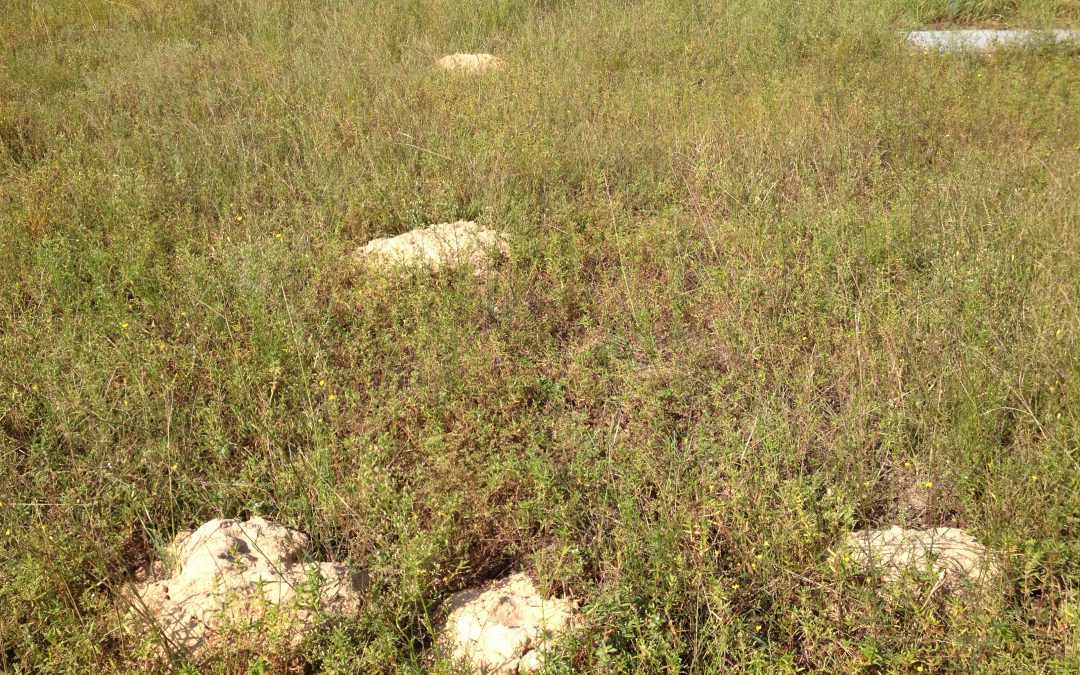
by Larry Williams | Sep 23, 2016

Mounds of sand made my pocket gopher along roadside. Photo Credit: Larry Williams
Pocket gopher is a furry animal known by many locals as “sandy mounder.” It was given this name because of the sandy mounds of excavated earth that the gopher pushes out of its underground burrows. The name sandy mounder, with time, became “salamander.” This animal is not a salamander at all. Salamanders are slimy amphibians shaped like lizards. Salamanders are often known as “spring lizards” in Florida.
To make this nomenclature problem more confusing, in some areas of Florida gopher means a certain burrowing tortoise – the gopher tortoise.
To simplify things keep in mind that in Florida “spring lizard” can mean “salamander” and “salamander” can mean “gopher” and “gopher” can mean “turtle.”
“Gopher” is a confusing word all over the country. Jeff Jackson, retired wildlife biologist with University of Georgia Extension says, “The Richardson’s ground squirrel of the west is called gopher. So is the thirteen lined ground squirrel of the Great Plains and Midwest. Moles are called gophers in many areas. And voles (certain short-tailed mice) are called gophers in some states.”
Jackson says there are six species of “sure enough, genuine pocket gophers in the United States.” Our pocket gopher is the Southeastern Pocket Gopher, found in north Florida, south Alabama and south Georgia.
The pocket gopher spends its time underground making tunnels and nests, eating roots and bearing and raising young. It may venture into residential areas where it can damage plants by feeding on tree and shrub roots or bulbs and tubers of various plants.
A pocket gopher can make fifty or more sandy mounds in a relatively short period of time. These mounds, which are normally four to six inches high and possibly a foot across, are what get homeowners’ attention. The mounds can “popup” overnight in lines or rows. They resemble fire ant mounds; however, they contain no ants.
The pocket gopher is a rodent that grows to about a foot long, has a short tail and weighs about half a pound. Its name comes from the large fur-lined pouches on the outside of its cheeks.
Even though they do contribute to the formation of soil and provide a food source for some predators, sometimes their damage may justify control measures.
Trapping is the most effective option. No chemical repellents are known to be effective. It’s illegal to use any poison to kill gophers. Vibrating devices have not been proven to repel gophers. A long held belief that Wrigley’s Juicy Fruit gum kills gophers by blocking their digestive system has been proven to be false.
A detailed fact sheet is available online at http://edis.ifas.ufl.edu/uw285.

by Matt Lollar | Sep 8, 2016
Plants can become distorted for a wide variety of reasons. Sometimes nutrient deficiencies or toxicities can cause plants to become distorted. Sometimes excessive amounts of water or sunlight can cause plants to become distorted. And sometimes insect feeding damage can be the culprit.
Insects can cause plant mutations by feeding alone or by vectoring disease from one plant to another. The most recent and most detrimental example of insects vectoring disease is the Asian Citrus Psyllid, which has distributed Huanglongbing, also known as citrus greening, to most of the citrus acreage in Florida and across the United States. Fortunately, the panhandle is currently free from this detrimental disorder. However, we still have a plethora of insects that distort plants by one way or another. One group of plant altering insects are commonly known as planthoppers.
Planthopper adults range in size between 1/8 to 1/4 inches long. They are slender and frequently have an angular, pointed head. Coloration depends on species, but generally planthoppers are of green, brown, or white. Immatures look similar to the adults except they are smaller and don’t have wings. Immatures typically feed on the underside of leaves, where the humidity is higher and they are more protected from predators.

Three growth stages of planthoppers. Photo Credit: UF/IFAS Extension
Planthoppers feed on plant leaves and shoots by sucking out the contents. The damage that ensues from feeding depends on the host plant and the hopper species. A few species of hoppers transmit pathogens that can alter plant growth. Usually, adult hoppers are pests only when found in high numbers.
Feeding damage from some species causes small white spots (stippling) to appear on the upper leaf surface, usually beginning near the leaf midrib. Stippled areas eventually merge together into larger whitish blotches. In some plants, feeding damage causes a drying and yellowing (or browning) of leaf tips and some planthopper species cause curling or stunting of newly formed leaves. Oftentimes, white, papery skin castings will remain from the molting process on the undersides of leaves.
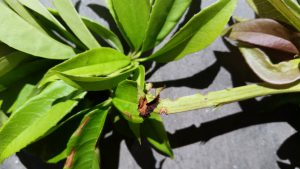
Planthopper feeding damage on sweet olive. Photo Credit: UF/IFAS Extension
Planthoppers are rarely present in large enough numbers to cause significant plant damage. Fortunately, planthoppers have many natural enemies including lady beetles, lacewings, damsel bugs, and spiders. Sticky traps are recommended to help monitor planthopper populations. Planthoppers are usually attracted to yellow sticky traps that can be placed among the plant leaves. Small populations can be managed using these traps. If greater populations are present, then insecticidal soap can control young planthoppers. Make sure to spray both the top and underside of the leaves.
Planthoppers are minor pests in the landscape, but they can cause alarming mutations in plant material. Contact your local Extension Office for help with diagnosis and treatment options.
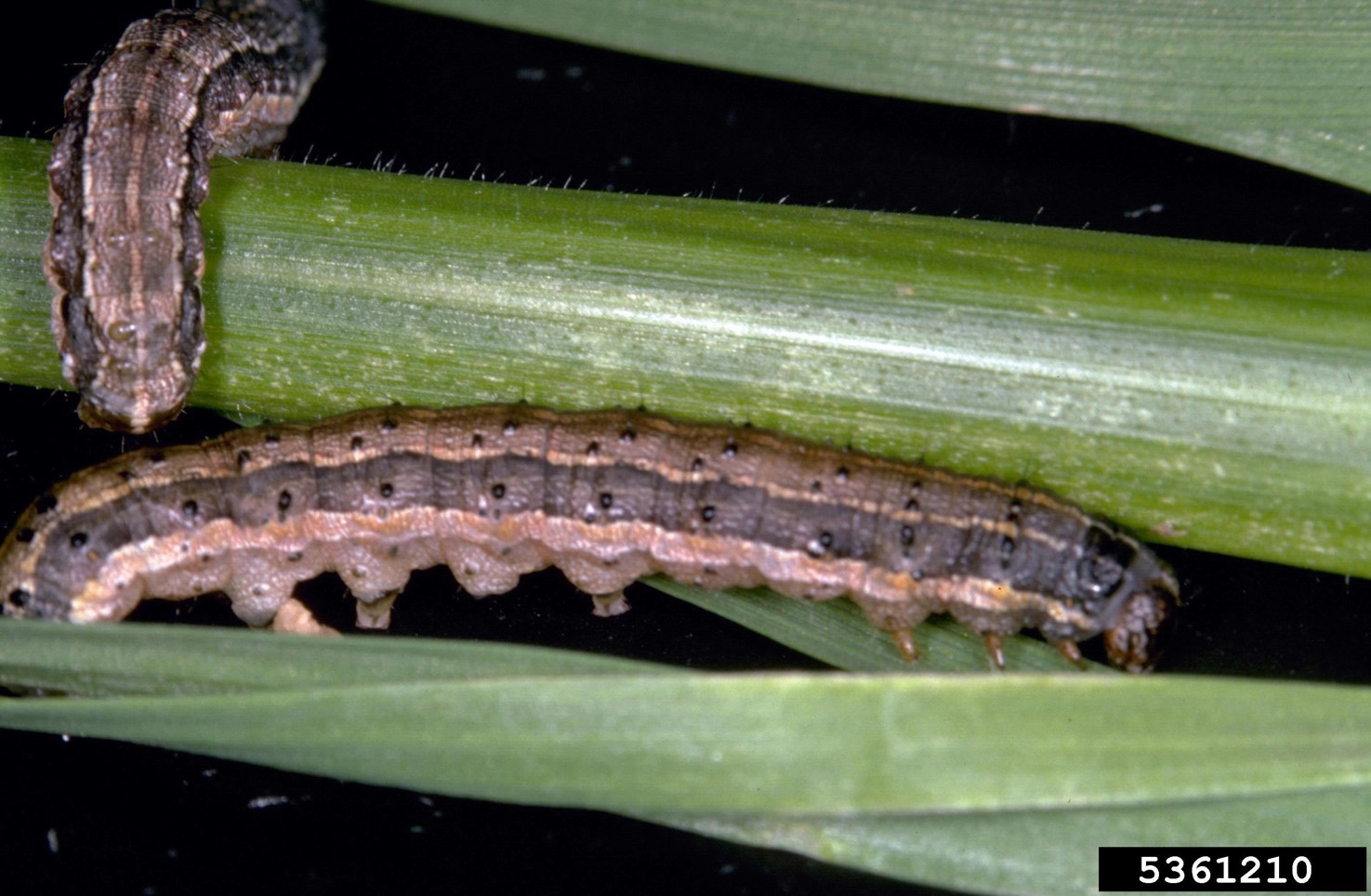
by Larry Williams | Sep 2, 2016
Tropical sod webworms have been active in local lawns during the past few weeks here in North Florida. All of our warm season turf grasses are susceptible to these pests.
Sod webworms are not consistently a problem every year. Some years their numbers are low enough that they are not a problem. Some years we do not see them at all. Those years when they are a problem, it’s usually not until late summer and early fall that they become active and they may continue to feed on lawns until frost occurs.
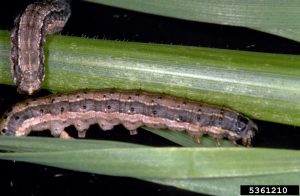
Fall armyworm. Photo credit: Frank Peairs Colorado State University, bugwood.org.
Fall armyworms and sod webworms can attack at the same time. Sod webworms are the smaller of the two species, reaching a length of about ¾ inch. Armyworms grow to ½ inch in length. Both of these caterpillars are greenish when young, turning brown at maturity. Armyworms generally have a light mid-stripe along their back with darker bands on either side of the mid-stripe. Their feeding is similar, resulting in notched or ragged leaf edges.
Sod webworms tend to feed in patches while armyworms cause more scattered damage. Sod webworms feed at night while armyworms will be seen feeding during the day. Sod webworm caterpillars rest, curled up near the soil surface during the day. Adults of both species are fairly small grayish to brown moths.
If your lawn has damaged spots, look closely for notched leaf blades from their chewing. You may first notice a patch in your lawn that looks like it has been mowed extra low. Closer inspection reveals grass blades that are chewed away. Caterpillar feeding on zoysiagrass shows up more as translucent whitish tan areas on the surface of individual blades more so than as notched blades.
Fall armyworms and sod webworms can be controlled with the same insecticides as the other lawn insects. But you also may use insecticides that contain Bacillus thuringiensis; a bacterium that only kills caterpillars. Control should only be directed against the caterpillars, not the non-feeding, flying adult moths. Always follow the label directions and precautions for any pesticide you use.
For more information on lawn caterpillars contact the UF/IFAS Extension Office in your County or visit http://edis.ifas.ufl.edu/topic_tropical_sod_webworm.
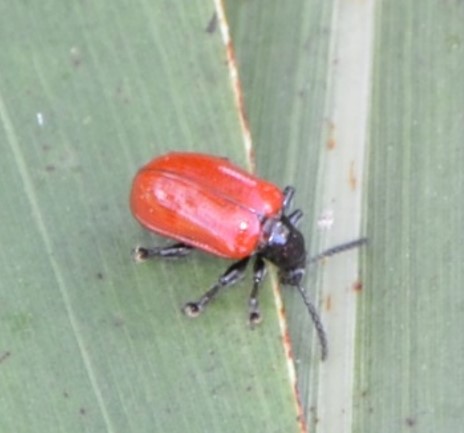
by Les Harrison | Aug 23, 2016
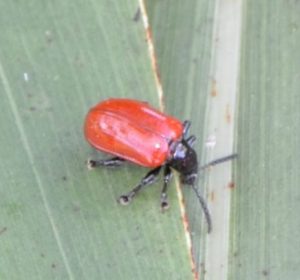
Air potato leaf beetle. Photo credit: Les Harrison, UF/IFAS.
A small, but brightly colored beetle has appeared in north Florida: the air potato leaf beetle (Liliocetis cheni), a native of East Asia. The beetle, less than half an inch long, has a candy apple red body that stands out against green leaves and the more muted earth tones of most other bugs. The striking bright glossy red coating would be the envy of any sports car owner or fire truck driver.
Unlike other arrivals to the U.S., this insect was deliberately released in 2012 for biological control of air potato. After years of testing, approval was finally given to release air potato leaf beetles to begin their foraging campaign against this invasive plant species. The beetle has very specific dietary requirements and only can complete its life cycle on air potato. The larvae and adults of this species consume the leaf tissue and occasionally feed on the tubers.
When a population of air potato leaf beetles finish off an air potato thicket, they go in search of nourishment from the next patch of air potato. They are sometimes seen during stopovers while in search of their next meal.
Air potato (Dioscorea bulbifera) is an herbaceous perennial vine which is easily capable of exceeding 60 feet in length. It quickly will climb over any plant, tree or structure unfortunate enough to be in its vicinity. The vine also produces copious quantities of potato-like tubers suspended from its vines. Unless collected and destroyed, most of the easily camouflaged potatoes will germinate and intensify the infestation.
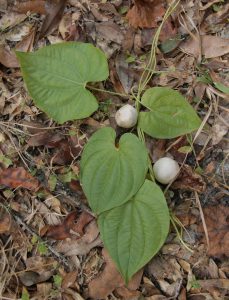
Air potato. UF/IFAS Photo: Thomas Wright.
Air potato came to Florida in 1905 from China and quickly escaped into the wild. By the 1980’s it was a serious pest species in south and central Florida, but has gradually become established in the panhandle, too. Chemical control of the air potato has been difficult. Repeated herbicide treatments are required to kill a thicket with multiple plants.
Unlike the air potato leaf beetle that only eats air potato, kudzu bugs eat their namesake vine (kudzu), but also feed on a number of other plants including a wide selection of valuable legumes and be quite destructive. Kudzu bugs were accidently introduced in north Georgia in 2009 and have spread across the south in the ensuing years and become established in north Florida.
It is a pleasant surprise to know air potato leaf beetles are working to limit the invasive air potato vine, but it is sad to think there is plenty more for them to eat.
To learn more about the air potato and the beetle:
Natural Area Weeds: Air Potato (Dioscorea bulbifera)
Air Potato Leaf Beetle Publication

by Sheila Dunning | Aug 19, 2016
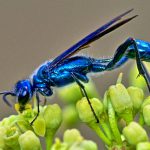 With all the media discussion of “bad” insects, like mosquitoes, many of the good guys are forgotten. One that has been very active this summer is the blue mud dauber, Chalybion californicum. These wasps are metallic blue, blue-green or blackish in color with very short narrow waists. During the summer, female blue mud daubers build nests by bringing water to abandoned mud nests made by other species of mud dauber wasps. They form new mud chambers, stock them with paralyzed spiders and a single egg, then seal the chambers with more mud. Their offspring stay in the chamber, feeding on the spiders, and then pupate in a thin silk cocoon. They spend the winter in the nest, emerging the following spring as adults.
With all the media discussion of “bad” insects, like mosquitoes, many of the good guys are forgotten. One that has been very active this summer is the blue mud dauber, Chalybion californicum. These wasps are metallic blue, blue-green or blackish in color with very short narrow waists. During the summer, female blue mud daubers build nests by bringing water to abandoned mud nests made by other species of mud dauber wasps. They form new mud chambers, stock them with paralyzed spiders and a single egg, then seal the chambers with more mud. Their offspring stay in the chamber, feeding on the spiders, and then pupate in a thin silk cocoon. They spend the winter in the nest, emerging the following spring as adults.
Blue mud daubers are solitary wasps and not known to be aggressive. When the females have carried water to an old black and yellow mud dauber’s nest, she softens it and remolds it to her needs. The result is a very lumpy version of the originally smooth nest. Next she must fill the nest with food for her future offspring. The blue mud dauber prays on spiders.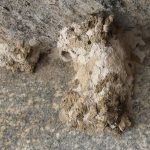
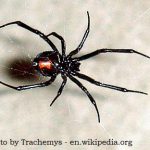 If orb weavers, lynx or crab spiders are plentiful, the blue mud dauber is able to land on their web without getting entangled and pluck the web to simulate an insect in distress. When the spider rushes to capture its prey, the poor arachnid becomes the victim of the wasp’s paralyzing sting and is quickly flown to the mud nest. However, the preferred host of the blue mud dauber is the southern black widow. Even without the elaborate web game, this wasp can control a dangerous nuisance. Once at the nest with her spider victim, the blue mud dauber stores the paralyzed arachnid at the bottom of a mud cell and lays a single egg onto its body. When the wasp larva hatches it consumes the remaining body of the spider. With a full belly, the mature larva spins a papery silken cocoon within the mud nest and begins to pupate. The following spring an adult wasp chews a round hole in the end of the mud cell and exits it’s winter home.
If orb weavers, lynx or crab spiders are plentiful, the blue mud dauber is able to land on their web without getting entangled and pluck the web to simulate an insect in distress. When the spider rushes to capture its prey, the poor arachnid becomes the victim of the wasp’s paralyzing sting and is quickly flown to the mud nest. However, the preferred host of the blue mud dauber is the southern black widow. Even without the elaborate web game, this wasp can control a dangerous nuisance. Once at the nest with her spider victim, the blue mud dauber stores the paralyzed arachnid at the bottom of a mud cell and lays a single egg onto its body. When the wasp larva hatches it consumes the remaining body of the spider. With a full belly, the mature larva spins a papery silken cocoon within the mud nest and begins to pupate. The following spring an adult wasp chews a round hole in the end of the mud cell and exits it’s winter home.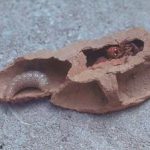
As adults, the blue mud dauber feeds on nectar from flowers and honeydew secreted by insects. Should you encounter a large congregation of this normally solitary wasp, don’t be alarmed. It is probably just a bunch of male blue mud daubers gathering together to sleep it off, after a heavy day of “drinking.”
So, rather than having to cover yourself in DEET just to spend the evening on the patio, brave the heat (with water bottle in hand, of course) and spend the daytime hours watching the blue mud daubers prepare their nest for next year’s young. Maybe the media will pick up on wasp that are reducing black widow populations, rather than the dangers of mosquitoes.
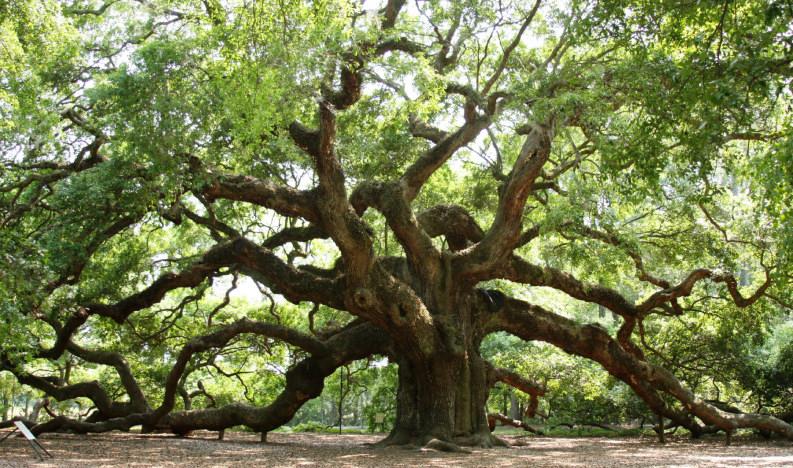
by Daniel J. Leonard | Jul 26, 2016
The Live Oak (Quercus virginiana) is one of the most iconic figures of the Deep South. Mentioning the words Live Oak invokes all sorts of romantic nostalgia of yesteryear and the reputation is not unearned. In fact, many Live Oaks still stand that were growing on American soil when the first English settlers set foot on Plymouth Rock. They are long-lived, picturesque trees that also happen to be nearly bulletproof in the landscape. Given these factors, it is not surprising that Live Oak is far and away the most common tree included in both residential and commercial landscapes in the Coastal South. However, even the venerable Live Oak is not without its problems; this article will discuss a few of the more common issues seen with this grand species.
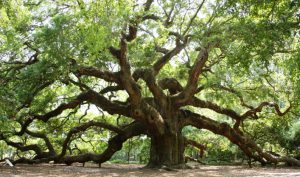
The Angel Oak near Charleston, SC
Few conditions afflict live oak but when they do, improper planting or cultural practices are usually at play. Observing the following best management practices will go a long way toward ensuring the long-term health of a planted Live Oak:
- Remember to always plant trees a little higher than the surrounding soil to prevent water standing around the trunk or soil piling up around it, both of these issues frequently cause rot to occur at the base of the tree.
- If planting a containerized tree, remember to score the rootball to prevent circling roots that will eventually girdle the tree. If planting a B&B (Balled and Burlap) specimen, remember to remove the strapping material from the top of the wire basket, failure to do this can also result in the tree being girdled.
Live Oak has few insect pests but there are some that prove bothersome to homeowners. The following are two of the most common pests of Live Oaks and how to manage them:

Typical galling on Live Oak
Galls are cancerous looking growths that appear on the leaves and twigs of Live Oak from time to time and are caused by gall wasps that visit the tree and lay their eggs inside the leaf or stem of the plant. The larvae hatch and emerge from the galls the following spring to continue the cycle. These galls are rarely more than aesthetically displeasing, however it is good practice to remove and destroy gall infected stems/leaves from younger trees as gall formation may cause some branch dieback or defoliation. Chemical control is rarely needed or practical (due to the very specific time the wasps are outside the tree and active) in a home landscape situation.
- Black Twig Borers can also be problematic. These little insects seldom kill a tree but their damage (reduction of growth and aesthetic harm) can be substantial. Infestations begin in the spring in Northwest Florida, with the female twig borer drilling a pen-head sized hole in a large twig or small branch and then laying her eggs in the ensuing cavity. She then transmits an ambrosia fungus that grows in the egg-cavity, providing food for the borer, other borer adults, and her offspring that take up residence and over-winter in the twig. The activity of the insects in the twig has an effect similar to girdling; the infected twig will rapidly brown and die, making removal and destruction of the infected branches a key component
In conclusion, though there are a few problems that can potentially arise with Live Oak, its premier status and continued widespread use in the landscape is warranted and encouraged. It should be remembered that, relative to most other candidates for shade trees in the landscape, Live Oak is extremely durable, long-lived, and one of most pest and disease free trees available. Happy growing!


















